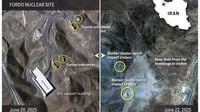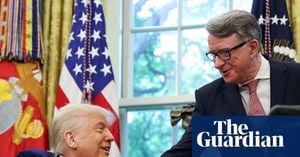The fate of Iran’s nuclear program has been thrown into fresh uncertainty following a series of dramatic events that have left both the international community and regional powers on edge. In the wake of Israeli and U.S. airstrikes that rocked Iran’s most sensitive nuclear facilities in June 2025, Tehran has now publicly acknowledged that its stockpile of enriched uranium – including material near weapons-grade levels – is buried beneath the rubble of bombed sites. The admission, made by Iranian Foreign Minister Abbas Araghchi on September 11, 2025, has only deepened the mystery surrounding the country’s nuclear capabilities and intentions.
According to Iranian state television, Araghchi stated that approximately 408 kilograms of uranium enriched close to weapons-grade remain trapped under the debris of installations struck during the 12-day offensive. He added, “The Atomic Energy Organisation of Iran is still trying to determine whether the fissile material can be retrieved.” The strikes, which targeted major nuclear sites at Fordow, Natanz, and Isfahan, marked one of the most significant escalations in the long-running standoff over Iran’s nuclear ambitions.
Iran’s confirmation of the uranium’s location came after weeks of speculation and mounting pressure from Western governments. On September 12, Iranian officials reiterated to the international press that the enriched uranium stockpile remains buried under the bombed nuclear sites, aligning with earlier reports following the June airstrikes by Israel and the United States. The timing of these statements was no accident, as the world’s attention has been fixed on what remains of Iran’s nuclear program – and what risks may still lie beneath the surface.
The aftermath of the June conflict has been marked by a troubling lack of transparency. Since the strikes, Iran has suspended its cooperation with the International Atomic Energy Agency (IAEA), the United Nations’ nuclear watchdog. This move has prevented independent verification of the destruction at the bombed sites and made it impossible to track the status of the enriched uranium. As a result, Western diplomats and nuclear experts have been left in the dark, with some suggesting that Tehran may have relocated at least part of its reserves ahead of the strikes.
This ambiguity has not gone unnoticed. The so-called E3 – the United Kingdom, France, and Germany – have cited Iran’s refusal to allow inspectors back in and its failure to clarify the whereabouts of the uranium stockpile as key reasons for triggering the United Nations “snapback” sanctions mechanism on August 28, 2025. This mechanism, established under the 2015 nuclear deal, reactivates sanctions that had previously been lifted unless Iran meets certain conditions within 30 days. Chief among these requirements are restoring access for the IAEA and resuming nuclear talks with the United States, which have been stalled since the surprise attacks in June.
The looming sanctions deadline at the end of September has injected a new sense of urgency into the situation. According to the Financial Times, the lack of clarity regarding Iran’s uranium stockpile has heightened Western fears that Tehran is deliberately maintaining ambiguity to preserve bargaining leverage. Ellie Geranmayeh, a senior policy fellow at the European Council on Foreign Relations, told the newspaper, “For Tehran, maintaining uncertainty over the stockpile is one of the few bargaining chips it still has. It allows Iran to keep weaponisation options theoretically open, but more likely, to draw the Trump administration back into negotiations.” She added that the European demands for proof appeared “detached from the realities following the June strikes.”
From the U.S. perspective, the military operation was both a tactical and diplomatic gambit. Former Deputy Assistant Secretary of State Joel Rubin, speaking to Iran International on September 12, stated, “US attacks on Iranian nuclear sites forestalled their potential push toward a bomb but a deal must be reached to guarantee Tehran will not go nuclear.” Rubin, who served in the Obama administration and now writes for The Briefing Book on Substack, explained that President Donald Trump’s envoys had been engaged in tense negotiations with Tehran for two months prior to the June attacks, seeking assurances that Iran would not acquire a nuclear weapon.
Rubin did not mince words about the effectiveness of the strikes: “I supported the American response. I believe that it set back the program. I believe it was devastating.” However, he emphasized that military action alone was not enough. “I also believe there needs to be a diplomatic agreement to lock in those gains,” Rubin said. “If they really want to get international faith restored, they need to come clean. They need to allow full inspections. They need to say they want to go back into a nuclear deal with the world.”
Despite the apparent setback to Iran’s nuclear program, skepticism remains high among Western governments. Trump himself declared that the attacks “obliterated” Iran’s program, but many diplomats and experts remain unconvinced. They point to the possibility that Iran may have safeguarded parts of its stockpile elsewhere, and note that the country’s suspension of IAEA cooperation only fuels suspicions.
The European troika’s decision to trigger the snapback mechanism was not taken lightly. Under the 2015 nuclear agreement, any party can reimpose UN sanctions after a 30-day period if Iran is found to be in non-compliance. Tehran has bristled at the move, arguing that a recent deal to resume inspections with the UN nuclear watchdog will be undermined by the European sanctions. In the words of Joel Rubin, “They are in violation of multiple international standards. They have essentially prioritized the nuclear program over their people. We have a dynamic where the Europeans, even though they were concerned about the military action taken in June, they have no confidence in what the Iranian government is saying.”
As the clock ticks down to the end of September, the standoff between Iran and the West shows no sign of resolution. With the fate of hundreds of kilograms of enriched uranium literally buried and the world’s nuclear watchdog sidelined, the diplomatic window appears to be closing fast. The question now is whether the threat of renewed sanctions will bring Iran back to the negotiating table – or push the region closer to another dangerous escalation.
For now, the world waits. The echoes of the June airstrikes still reverberate through the halls of diplomacy, and the uncertainty over Iran’s nuclear future remains as impenetrable as the rubble that covers its most sensitive secrets.





